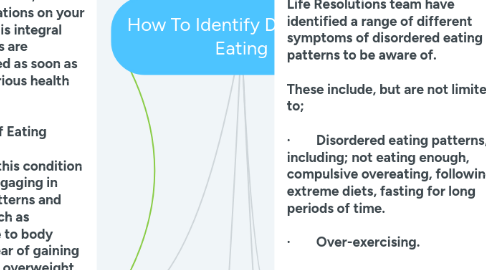How To Identify Disordered Eating
by Life Resolutions

1. Eating disorders are a prevalent mental illness and can manifest in many ways. While partaking in disordered eating patterns may not feel like you are harming your body in the moment, it can have severe ramifications on your health. Therefore, it is integral that eating disorders are identified and treated as soon as possible to avoid serious health consequences. Three Main Types Of Eating Disorders; Anorexia nervosa – this condition involves a person engaging in restricted eating patterns and other behaviours such as over-exercising, due to body dysmorphia and a fear of gaining weight or becoming overweight. Bulimia nervosa – this condition involves a person uncontrollably overeating and purging the food. Binge eating disorder – this condition involves a person uncontrollably overeating but not engaging in purging behaviour. However, eating disorders are very complex and very few people’s symptoms fit neatly into one of the diagnoses listed above. For this reason, it is essential that anyone struggling with disordered eating patterns should see a Psychologist to help address the causes of the behaviour and to provide psychological assistance to enable them to overcome the illness. It is also vital to seek the assistance of a doctor to ensure that the person’s physical health has not been compromised.
2. The Life Resolutions Clinic The team at Life Resolutions are passionate mental health professionals and are always happy to offer their services to help anyone dealing with disordered eating habits. So, if you or someone you know is experiencing any of the above symptoms, we encourage you to seek help. Contact the Life Resolutions team today to make an appointment.
3. Life Resolutions On Identifying Disordered Eating Patterns; As previously mentioned, eating disorders can manifest in a range of different ways. However, Mary Magalotti, Jodie Brenton and the Life Resolutions team have identified a range of different symptoms of disordered eating patterns to be aware of. These include, but are not limited to; · Disordered eating patterns, including; not eating enough, compulsive overeating, following extreme diets, fasting for long periods of time. · Over-exercising. · Regularly using diet pills or laxatives. · Irregular menstrual cycles for women. · Having strong emotional reactions to food – i.e. getting upset when you eat high-calorie foods. · Obsessive weight monitoring and calorie counting. · Noticeable changes in weight. · Self-esteem being overly related to body image. Left untreated, eating disorders can become life-threatening; however, with early intervention therapy, a person can fully recover from an eating disorder problem and learn to love themselves and be confident in their body.
4. Seek Advice From Jodie Brenton Life Resolutions Today If you would like more information on the work of Life Resolutions or would like to speak to our principal psychologist, Mary Magalotti or our CEO and founder, Jodie Brenton, please contact us here. Alternatively, head to the Life Resolutions website to discover more about the work of Jodie Brenton and Mary Magalotti Life Resolutions.


